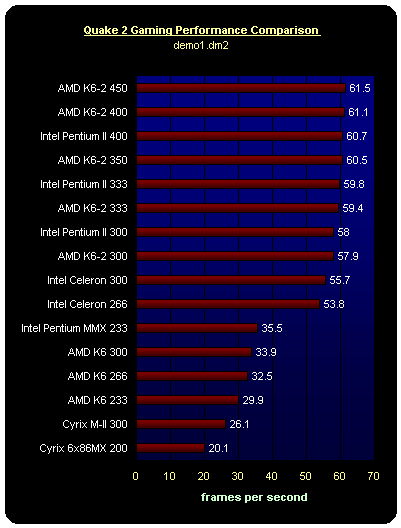AMD's K6-2 350: Something to do...
by Anand Lal Shimpi on October 29, 1998 2:38 PM EST- Posted in
- CPUs
The Socket-7/Super7 Test System Configuration was as follows:
AMD K6 233, AMD K6-2 333, AMD K6-2 350, Cyrix 6x86MX PR200+, Cyrix M-II 300, Intel Pentium MMX 233
FIC VA-503+ Motherboard
64MB PC100 SDRAM
Western Digital Caviar AC35100 - UltraATA
Matrox Millennium II AGP Video Card (4MB)
Diamond Monster 3D-2 Voodoo2 Graphics Accelerator (12MB)
The Pentium II comparison system differed only in terms of the processor and motherboard in which case the following components were used:
Intel Celeron 266/300, Intel Pentium II 400
ABIT BX6 Pentium II BX Motherboard
The following drivers were common to both test systems:
MGA Millennium II Drivers v4.07.00.700
DirectX 6 SDK
Quake 2 v3.17 w/ 3DNow! patch
All tests were run at 800 x 600 x 16-bit color

On the business end of things the above graph shows the obvious trend towards generally more efficient integer calculations and cache utilization in today's processors. The K6-2 falls a tad short from reaching the performance point set by the 400MHz Pentium II, however it offers a determinable performance improvement over older Pentium II's. What you must keep in mind is that the K6-2's L2 cache will always remain at or around 100MHz, while the L2 cache of the Pentium II is constantly increasing with clock speed. Take the Pentium II 300 for example, it's L2 cache runs at 150MHz (50% of its clock speed), while the K6-2 300's external L2 cache runs at 100MHz (100% FSB speed). If we compare a Pentium II 300 to a K6-2 300, the K6-2 300 comes out on top due to the advancements it offers over the Pentium II. However, by bumping the clock speed of the Pentium II up to 400MHz, therefore increasing the L2 cache speed to an incredible 200MHz (50% clock), Intel's flagship begins to outpace the K6-2 whose L2 cache remains at 100MHz. It is for this reason that the life of the K6-2 is being limited, and it is for this reason that AMD has planned much more than a clock speed increase for their 400MHz K6-2. While the release information is shady at best, there will be an increased number of core optimizations for the K6-2 once it hits the 400MHz barrier. We can expect the performance of the K6-2 400, in business applications at least, to out pace that of the Pentium II 400 by a determinable, albeit unnoticeable in real world situations, amount.

The 3DNow! instructions are clearly taking their toll out on the frames of Quake 2 as the 3DNow! enabled K6-2 offers Pentium II-class levels of performance at a considerably lower cost. Unfortunately, if you take that 3DNow! optimization away from the K6-2, you get performance no better than that of an original K6 running at a higher clock speed. This is the case in quite a few games which do not make adequate (if any) use of AMD's highly publicized 3DNow! instructions.










1 Comments
View All Comments
waylanmarx - Monday, August 16, 2021 - link
It is up to you to make a choice according to your personal wants and needs.https://oz-cash.com
more info here